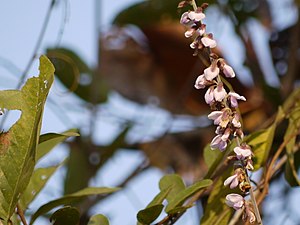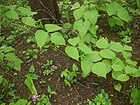Note: This is a project under development. The articles on this wiki are just being initiated and broadly incomplete. You can Help creating new pages.
Pueraria tuberosa - Vidarikanda
Vidarikanda is a large climber with trifoliate leaves and tuberous roots. It occurs in the Himalayan tracts at low elevations and also in the hills of Central and South India.
Contents
- 1 Uses
- 2 Parts Used
- 3 Chemical Composition
- 4 Common names
- 5 Properties
- 6 Habit
- 7 Identification
- 8 List of Ayurvedic medicine in which the herb is used
- 9 Where to get the saplings
- 10 Mode of Propagation
- 11 How to plant/cultivate
- 12 Commonly seen growing in areas
- 13 Photo Gallery
- 14 References
- 15 External Links
Uses
Joint pain, Burning sensation, Improve bodymass, Skin complexion, Improve voice quality [1]
Parts Used
Chemical Composition
Common names
| Language | Common name |
|---|---|
| Kannada | ಭೂ ಸಕ್ಕರೆ ಗಡ್ಡೆ Bhoo sakkare gadde, ಗುಮ್ಮಡಿ ಗಿಡ Gummadi gida |
| Hindi | Bidarikand, Bilaikand |
| Malayalam | Mutukku, Palmutukku |
| Tamil | Nelapoosani |
| Telugu | Darigummadi |
| Marathi | NA |
| Gujarathi | NA |
| Punjabi | NA |
| Kashmiri | NA |
| Sanskrit | Bhukushmandi, Kandapalasah |
| English | Indian kudzu |
Properties
Reference: Dravya - Substance, Rasa - Taste, Guna - Qualities, Veerya - Potency, Vipaka - Post-digesion effect, Karma - Pharmacological activity, Prabhava - Therepeutics.
Dravya
Rasa
Madhura (Sweet)
Guna
Guru (heavy), Snigdha (Slimy)
Veerya
Sheeta (cold)
Vipaka
Karma
Pitta, Vata
Prabhava
Habit
Identification
Leaf
| Kind | Shape | Feature |
|---|---|---|
| Trifoliate | Alternate | Leaflets 5-18 x 5-12.5 cm, ovate or the terminal rhomboid, base obtuse or acute, laterals oblique at base |
Flower
| Type | Size | Color and composition | Stamen | More information |
|---|---|---|---|---|
| Bisexual | Raceme | Bluish purple | 10 | Flowers c. 1.3 cm long, bluish-purple, ternate on the nodes of racemes; pedicels c. 3 mm long. Calyx c. 7 mm long, tomentose; tube campanulate; lobes ovate. |
Fruit
| Type | Size | Mass | Appearance | Seeds | More information |
|---|---|---|---|---|---|
| A Pod | 2.5-5.5 x 0.5-0.6 cm | Linear and hairy | {{{6}}} |
Other features
List of Ayurvedic medicine in which the herb is used
Where to get the saplings
Mode of Propagation
How to plant/cultivate
hoteIt is generally propagated by seeds, but seed germination is low. Tubers and layering is also used for raising plants.[5]
Commonly seen growing in areas
Tropical area, Sub tropical area
Photo Gallery
References
External Links
- Ayurvedic Herbs known to be helpful to treat Joint pain
- Ayurvedic Herbs known to be helpful to treat Burning sensation
- Ayurvedic Herbs known to be helpful to treat Improve bodymass
- Ayurvedic Herbs known to be helpful to treat Skin complexion
- Ayurvedic Herbs known to be helpful to treat Improve voice quality
- Herbs with Tuber used in medicine
- Herbs with common name in Kannada
- Herbs with common name in Hindi
- Herbs with common name in Malayalam
- Herbs with common name in Tamil
- Herbs with common name in Telugu
- Herbs with common name in Sanskrit
- Herbs with common name in English
- Habit - Climber
- Index of Plants which can be propagated by Seeds
- Index of Plants which can be propagated by Cuttings
- Herbs that are commonly seen in the region of Tropical area
- Herbs that are commonly seen in the region of Sub tropical area
- Herbs
- Fabaceae
- Ayurvedic herbs that don't have seed photos




